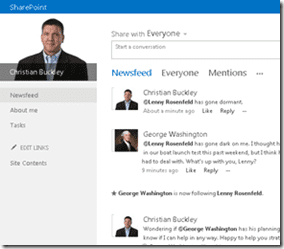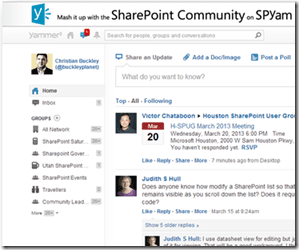Understanding Social Inside the Enterprise
This past Saturday, I was able to participate in my second SharePoint Saturday Cape Town event here in South Africa, providing the keynote address to a combined crowd of more than 380 SharePoint and SQL fans at the first “Community Saturday” event that brought SPS and SQL Saturday crowds together (there’s always been somewhat of an overlap from an infrastructure standpoint). This is my first road trip since the big news of the Metalogix acquisition of Axceler, and a chance to spend some time in the region with partners from both companies, as well as to help the South African SharePoint community grow. Aside from the keynote, which I conducted as an audience Q&A, discussing changes to SharePoint and to Microsoft as a whole — I also presented a regular session on the topic of SharePoint 2013 social features, Yammer, and how they compare to the most-requested social features (or platform) within the enterprise: Facebook.
If you’ve been following my articles on this site and elsewhere, you know that I often write about the need to align the unstructured collaboration strengths of social with the structured collaboration activities within content and document management systems, like SharePoint. My primary fear with the blind and sometimes rabid movement toward all things social is that it will lead companies down the same failed paths of their poorly designed/deployed structured collaboration platforms. Companies will quickly find themselves once again in a quandary if the right steps are not taken to closely align social communities and activities to business activities and goals. And that is the major underlying theme within my presentation below:
As shown below, the basic features end users want out of Facebook are available within both SharePoint and Yammer – but the difference is that both are inherently tied to business activities. SharePoint social activities are typically aligned with structured content, helping add context and metadata, improving the overall search experience. Yammer has less of a direct business connection, but tends to be used in association with communities of practice, bringing together people with the same backgrounds and experiences to collaborate. Even with these ties to the business, without clearly defined purpose, these two platforms can go from providing value to the enterprise to yet another information silo and budget sinkhole.
In The Social Organization by Bradley and McDonald (Gartner), the authors state “Social media, community, and purpose are the indispensable components that together produce mass collaboration.” All three components are necessary to enable successful social communities:
- Community. This is the “Who” of the social equation, and the scope of your efforts. For some initiatives, you may define your entire employee base as the community, while other initiatives may target only the product management team and a specific, external partner. Where you collaborate and why will change based on who is involved. Rarely, if ever, does a one-size-fits-all approach succeed within the enterprise.
- Social. Not every social tool or platform is the same. SharePoint and Yammer have very different value propositions. For one, Yammer will never be made available on premises – it was built in the cloud, for the cloud. SharePoint, on the other hand, functions whether it is on premises (installed on local servers) or in the cloud, but with features that tie it more closely to the structured document/records management features within the platform. You should pick the right tool for the community, and for the intended purpose.
- Purpose. This is the most critical aspect of successful enterprise collaboration – not just social within the enterprise. The point of deploying SharePoint, or Yammer, or any other tool within your corporate environment is to enable, optimize, improve, and innovate on top of your existing business processes. As the authors point out, you can develop a community with just about any social platform, but your chance of success without a clearly outlined purpose – some kind of business alignment – is something like 1 out of 10. Social without purpose is just chat.
I’m sure I’ll be posting once or twice more this week on the topic, as I’m in South Africa all this week talking to customers and partners about this topic (and how to manage it all through healthy governance practices).







